Melaleuca nesophila
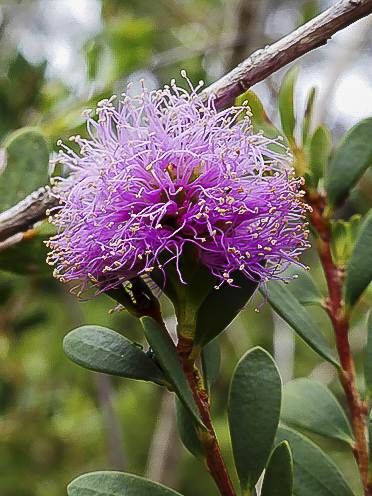
Melaleuca nesophila is known as the Showy Honey-myrtle and will usually develop into a tall shrub or small tree. In our cold climate garden plants have reached a height of three metres in more than ten years. Plants are upright, stiff with grayish, papery bark.
Melaleuca irbyana
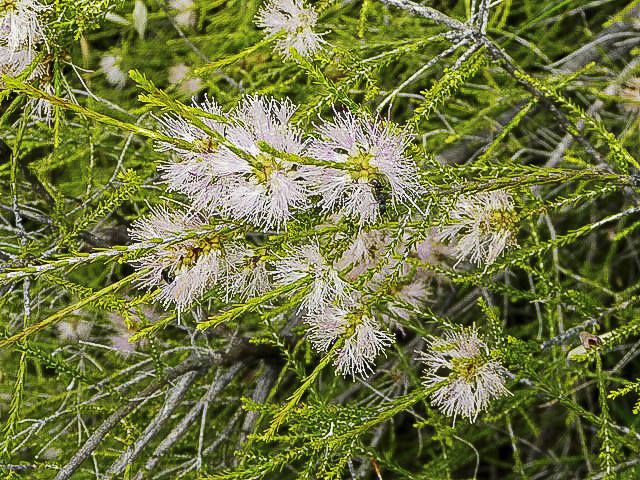
Melaleuca irbyana, Swamp Tea Tree, develops into a large shrub or small tree in the wild. In our cold climate garden plants only reach a height of about one metre. Plants, in another local garden, have grown into a similar size.
Melaleuca decora
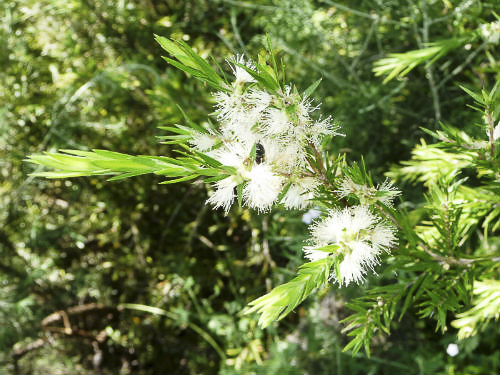
Melaleuca decora is a very tall shrub or small tree that may reach a height of 12 metres. The bark is light brown and papery. Leaves are light green, about 1.5 centimetres long and crowned with a point. Sweetly scented, white flowers are carried in spikes with individual flowers widely spaced.
Melaleuca bracteata
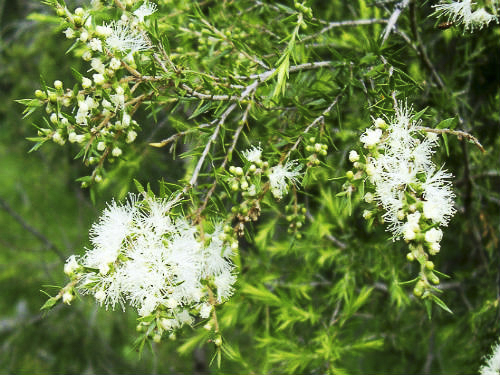
Melaleuca bracteata, Black Tea Tree grows into a small tree. The leaves are dark green, oval and scattered along the branches. Each leaf is equipped with a sharp point. Flowers are white and carried in clusters on or near the ends of the branches. The flowering season extends from August to November.
Lomatia fraseri
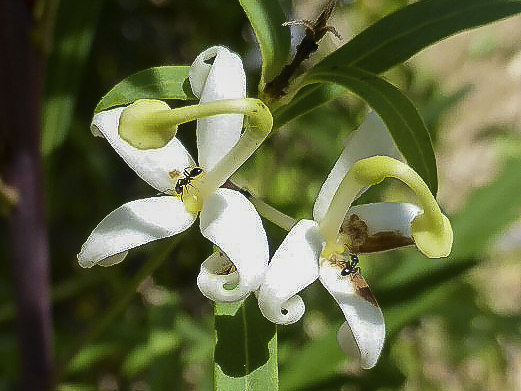
Lomatia fraseri is a member of the Proteaceae family and is known as Tree Lomatia, Forest Lomatia or Silky Lomatia. The species is a shrub or small tree reaching a maximum height of eight metres. The species is characterised by a variety of leaf shapes.
Hymenosporum flavum
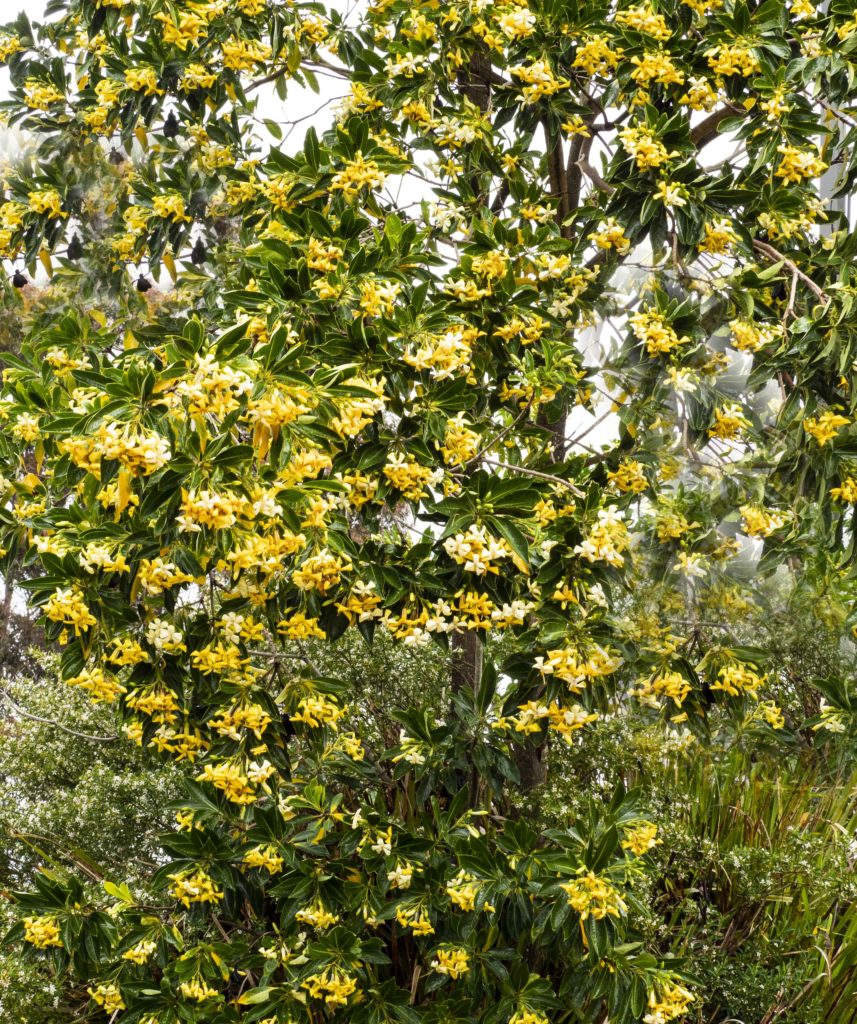
Hymenosporum flavum is a member of the Pittosporaceae family and is the only member of the genus. The common name is Native Frangipani and refers to the sweetly scented flowers reminiscent of the exotic frangipani. This is the only characteristic that they have in common.
Hibiscus divaricatus ‘Gold Haze’

Hibiscus ‘Gold Haze’ is a selected hybrid of H. heterophyllus (gold form) and Hibiscus divaricatus. It has large, showy, bright yellow flowers to about 8 to 10 cm in diameter with a red stripe surrounding the petal spot. With Hibiscus plants, the flowers only last for a day or so, however in its natural setting from the top of NSW to the eastern side of Cape York it has a long, nearly continuous flowering period.
Eucalyptus pulverulenta

Eucalyptus pulverulenta is known as the Silver-leaved Mountain Gum and develops into a tall shrub or small tree. In cultivation the species is usually seen as a tall, spreading shrub. The Silver-leaved Mountain Gum is an unusual Eucalypt (especially for eastern Australia) because it retains juvenile foliage into maturity. Plants rarely produce adult leaves.
Eucalyptus preissiana
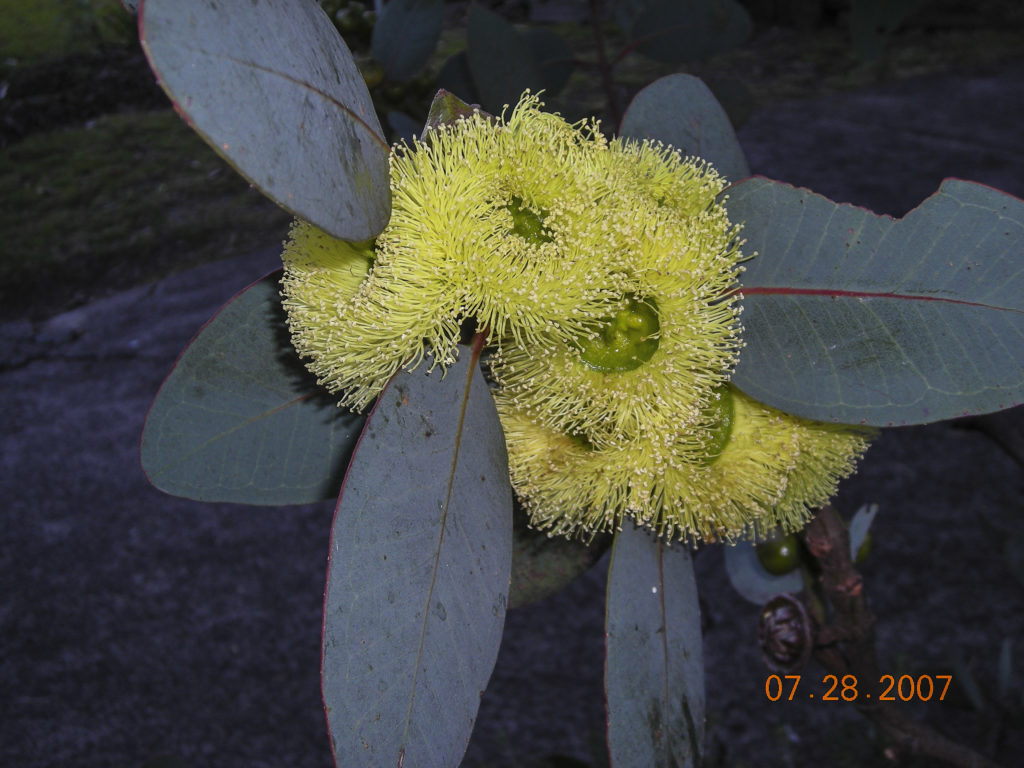
In my northern Sydney’s suburbs garden, I planted Eucalyptus preissiana ten years ago, after bringing it back from Western Australia (with a quarantine clearance). It has ‘mallee’ habit, that is, multi-trunks arising from a lignotuber and has only grown to 1.5 metres high by the same width. In the wild, it grows to 2 to 3 metres in height by a similar width.
Eucalyptus prava
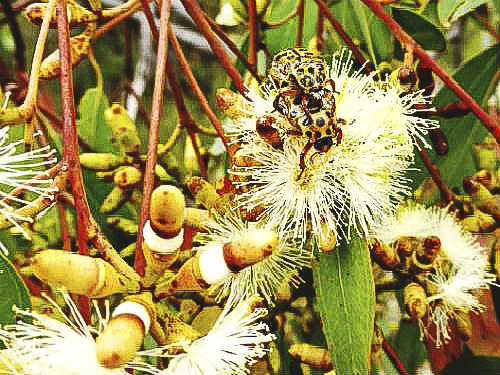
Eucalyptus prava , the Orange Gum, develops into a small to medium tree with a trunk that is often rather twisted. The bark is smooth and comes in a range of colours. Patchy grey, grey-brown, orange and red-brown are all colours in the palette of Orange Gum bark colours. In spring the bark is shed in large plates or flakes. This is when the orange colour is most vivid (hence the common name). As the year progresses this colour fades.
Eucalyptus olsenii
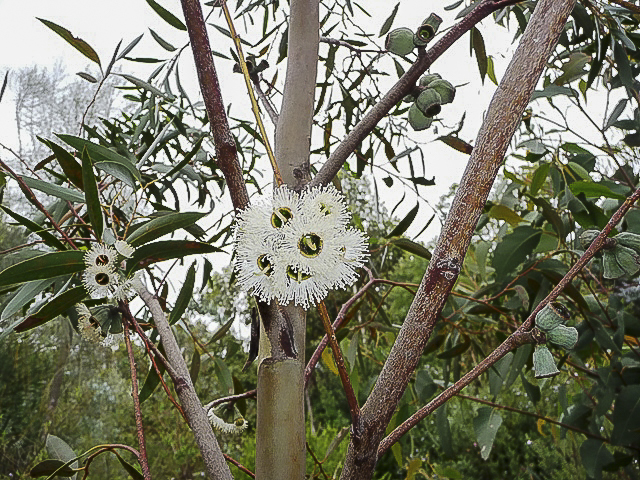
Eucalyptus olsenii is known as the Woila Gum and grows into a tree reaching 12 metres in height. The bark is rough on the lower part of the trunk whilst the rest of the trunk and branches are smooth, white, cream or grey. Leaves may be lance-like or curved, up to 12 centimetres long, two centimetres wide and glossy green. Buds are carried in clusters of seven and have distinctive ribs or ridges.
Eucalyptus michaeliana
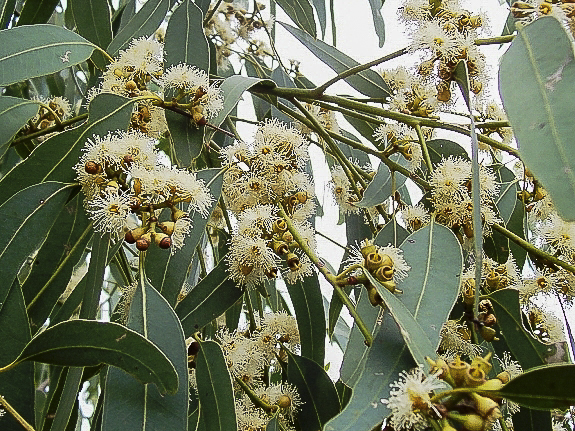
Eucalyptus michaeliana is known as the Hillgrove Gum. The common name refers to the village of Hillgrove, east of Armidale on the Northern Tablelands of NSW. A large population, of Eucalyptus michaeliana, occurs near the village.
Elaeocarpus reticulatus
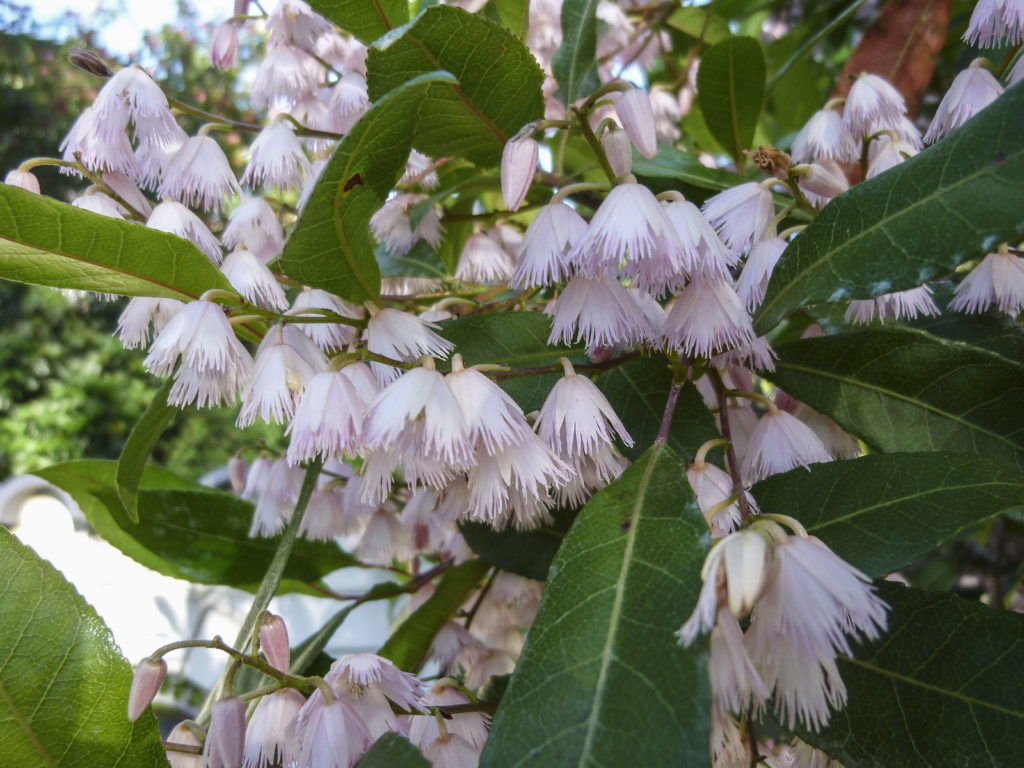
Elaeocarpus reticulatus should be growing in everyone’s garden! This is a popular, fast growing plant that has been in cultivation for well of 70 years. The common name is Blueberry Ash, because it produces many small bright blue berries about one centimetre in diameter after flowering.
Callitris pyramidalis
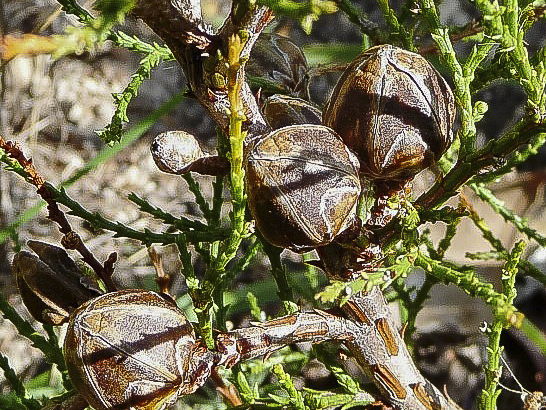
Callitris pyramidalis, known variously as the Swamp Cypress, Swan River Cypress and King George’s Cypress, is a tall shrub or small tree said to reach a height of eight metres. In our cold climate garden specimens reach about four metres after five years in the ground. They tend to attain a greater height with more watering. The typical Callitris foliage is dark green.
Acacia spectabilis

Acacia spectabilis, Mudgee Wattle is a tall spindly shrub or small tree with arching branches. The bipinnate leaves have pinnules or segments in four to eight pairs. Golden yellow flowers are held in globular clusters. Each cluster contains 20-35 individual flowers. The clusters are held in long racemes. Flowering is prolific from late winter to spring.
Acacia deanei
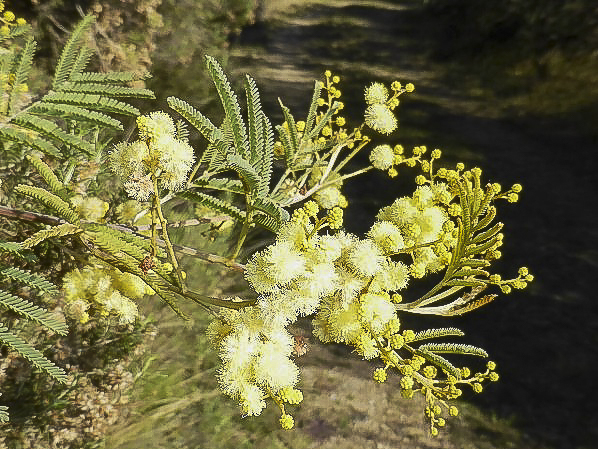
Acacia deanei, Deane’s Wattle, is a tall, upright shrub or small tree with light green bipinnate foliage. Plants carry pale yellow, globular flowers throughout the year. Both foliage and flowers are features of this attractive wattle. Deane’s Wattle will bring that spring time feeling to the garden throughout the year.
Acacia dealbata

Acacia dealbata, Silver Wattle, develops into a medium-sized tree that will reach a height of 30 metres. The flowers are held in globular clusters with 25-35 bright yellow flowers in each cluster. Blooms are carried from late winter to spring.
Acacia blakei ssp. diphylla
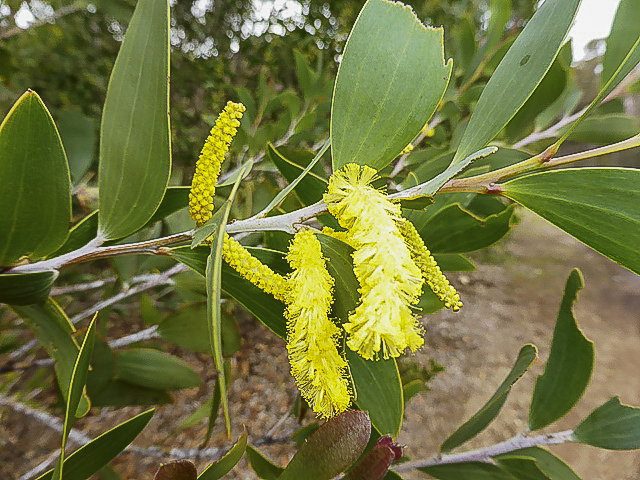
Acacia blakei ssp. diphylla is known as the Gorge Wattle. This common name refers to one of the species’ strongholds in the gorge country, east of Armidale in northern NSW. It grows in northern NSW near Gloucester with populations in south east Queensland
Eucalyptus magnificata

Eucalyptus magnificata is known as the Blue Box and is a tree that will reach a height of 15 metres. The bark is pale grey, fibrous and flaky. The leaves are oval and five to ten centimetres long by four to six centimetres wide. They are bluish-green in colour.
Eucalyptus macrandra
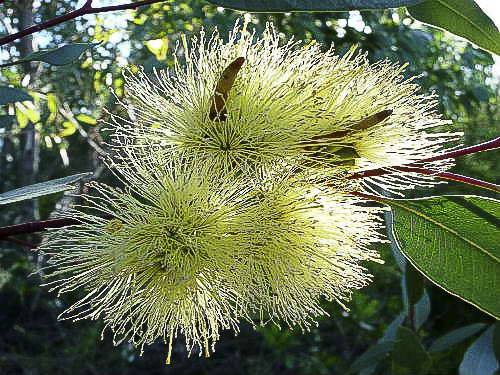
Eucalyptus macrandra, Long-flowered Marlock, is a mallee from 4 to 10 metres tall. Plants often produce multiple trunks that grow from a large lignotuber (swollen root mass). In our garden specimens confine their growth to one trunk. The bark is smooth, light brown and is shed in long strips then ages to grey.
Eucalyptus lansdowneana

Eucalyptus lansdowneana, Crimson Mallee, is a small tree that will reach a height of six metres. In the wild plants usually have multiple stems (mallee growth habit) but in cultivation plants usually restrict themselves to a single trunk.
Eucalyptus gregsoniana
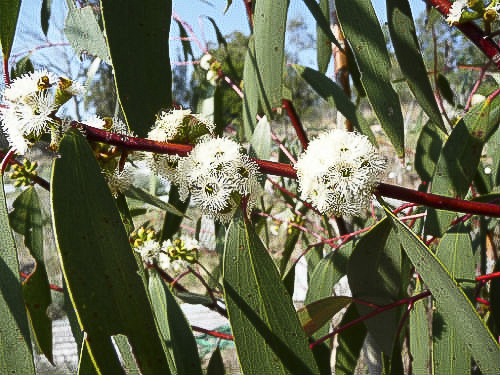
Eucalyptus gregsoniana, Wolgan Snow Gum is a tall shrub or small tree reaching a height of six metres. In the wild plants often develop mallee growth habit with multiple trunks. Cultivated specimens usually confine themselves to a single trunk. The bark is smooth, white or grey and shed in ribbons.
Eucalyptus gillii
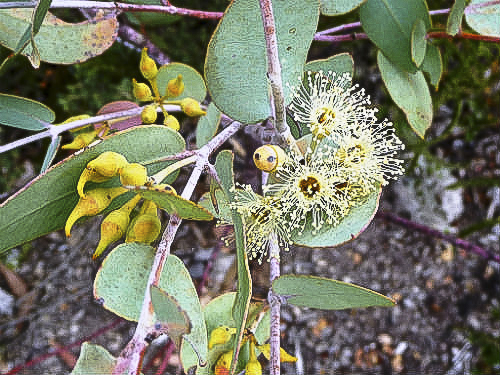
Eucalyptus gillii has various common names including Silver Mallee and Curly Mallee. Eucalyptus gillii is a small tree reaching a height of eight metres. Bark is smooth over most of the trunk with persistent flaky bark at the base. Leaves are lanceolate to broadly egg or heart shaped. They may be green, grey-green or blue-grey.
Eucalyptus curtisii
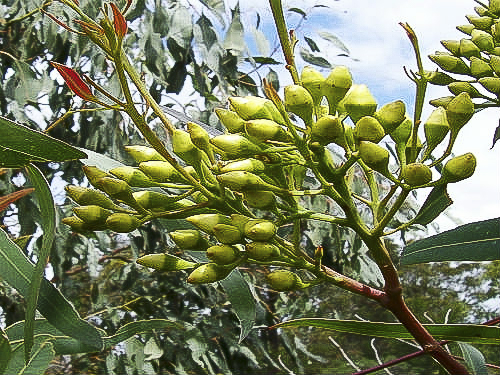
Eucalyptus curtisii, Plunkett Mallee, is a small tree that reaches a height of six metres. The bark is smooth, leaden grey to greenish-white and is shed in thin strips. Club-shaped buds are carried in large clusters. White, showy flowers appear in spring and early summer. Fruits are bell-shaped.
Eucalyptus crenulata
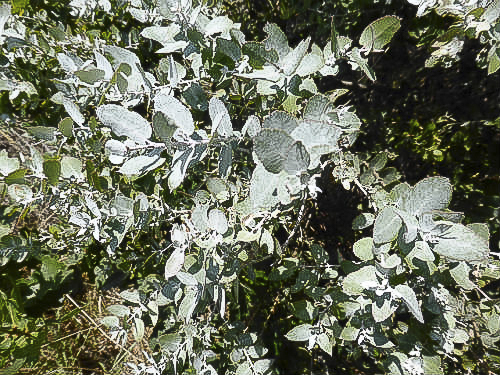
Eucalyptus crenulata, Buxton Gum or Silver Gum, is a medium-sized tree that will reach a height of 12 metres. Leaves are small, toothed, greenish-grey and used in cut flower arrangements. The foliage provides a contrast with other foliage in the garden. Leaf-eating insects such as scarabs seem to leave the foliage of the Buxton Gum alone.
Eucalyptus caesia

Eucalyptus caesia is commonly known as Gungurru. This Western Australian native is a small tree that may reach a height of nine metres if a single trunk develops. If the tree develops a mallee growth habit with multiple trunks then the height may be restricted to six metres. Our tree has a single trunk and is close to nine metres tall.
Eucalyptus boliviana
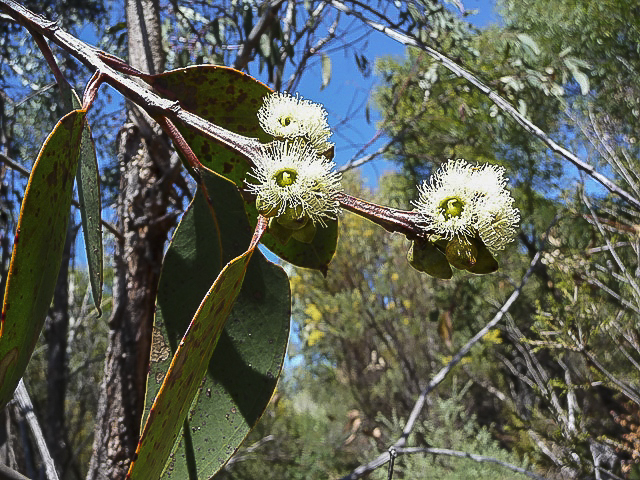
Eucalyptus boliviana is known as the Bolivia Hill Stringybark and develops into either a single-trunked tree reaching a height of about 12 metres or a five metre, multi-stemmed mallee. This mallee growth habit is probably triggered by bushfires and occurs in the wild. Cultivated plants will usually have a single trunk as does the specimen in our cold climate garden.
Eucalyptus baeuerlenii
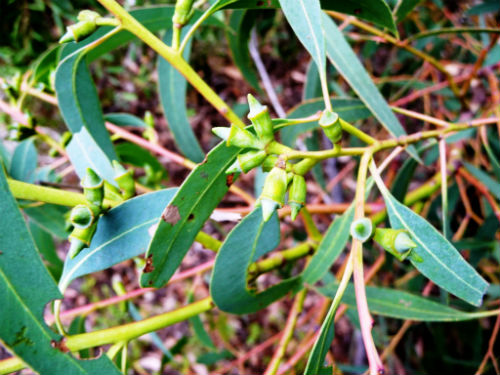
Eucalyptus baeuerlenii, Baeuerlen’s Gum, is a small to medium tree. In the wild plants usually have multiple trunks (mallee growth habit) due to the influence of bushfires. In cultivation plants usually restrict themselves to a single trunk.
Eucalyptus badjensis
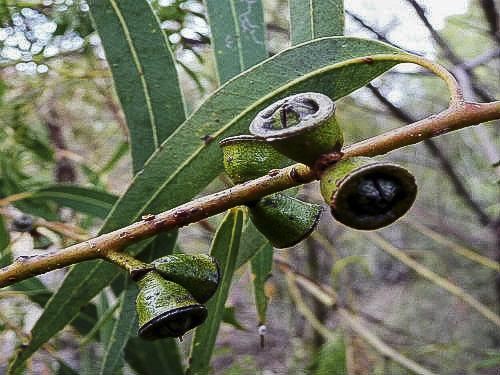
Eucalyptus badjensis, Big Badja Gum, will reach a height of at least 20 metres. The solitary trunk has persistent rough bark on the lower level. Upper parts are smooth, white, green or grey. Leaves are 20 centimetres long, 1.5 centimetres wide, lance-like and leathery.
Eucalyptus apiculata
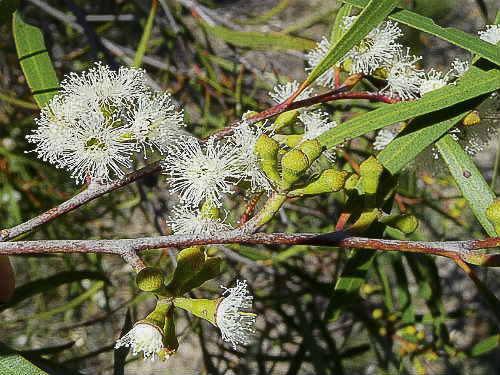
Eucalyptus apiculata, the Narrow-leaved Mallee Ash, is a small tree that will reach a height of six metres. In the wild, probably due to bushfires, plants may develop a multi-stemmed (mallee) growth habit. Cultivated specimens usually make do with a single trunk. Bark is smooth, white or grey-green and shed in strips.
Eucalyptus albens
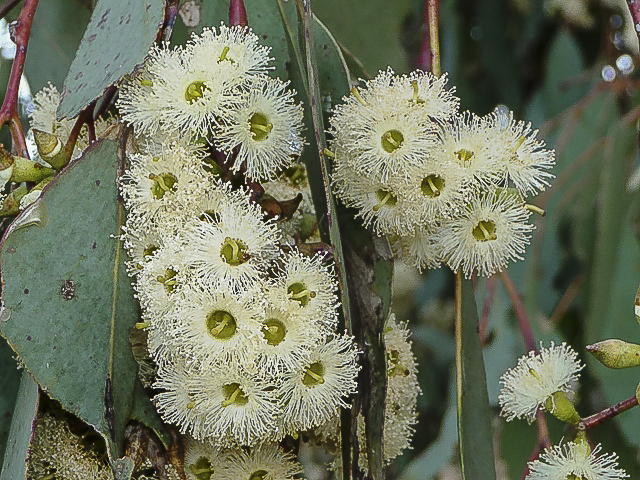
Eucalyptus albens, the White Box, will develop into a medium to tall tree. The trunk is short and straight. The crown is rounded to spreading. Bark is persistent, light grey to whitish with bleached patches. Branches are smooth and white. Leaves are oval to lance-like and are grey to bluish-green on both surfaces. The buds are carried in clusters of three to seven and are spindle-shaped.
Corymbia maculata
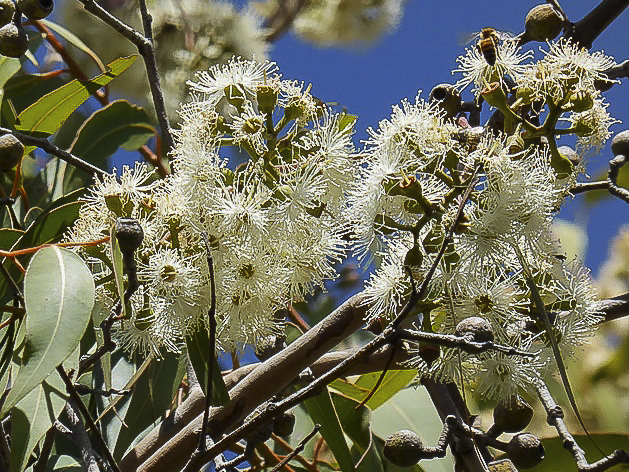
Corymbia maculata, the Spotted Gum, is a medium to tall tree usually with a solitary trunk.The bark is smooth, cream to dark grey or bluish and has a spotted or blotched appearance. Leaves are lance-like, dark green and rather shiny on both surfaces with prominent venation. The flowers are white, fragrant and carried in clusters of three to five. Prolific flowering occurs between May and September.
Callitris rhomboidea

Callitris rhomboidea s known as the Port Jackson Pine or Oyster Bay Pine. The common name depends on the location of the species. The former name refers to populations in NSW whist the latter common name refers to those in Tasmania. We will stick to Port Jackson Pine because of our location. The Port Jackson Pine is a small tree that may reach a height of 15 metres. Mature trees have an attractive pyramid shape.
Callitris endlicheri
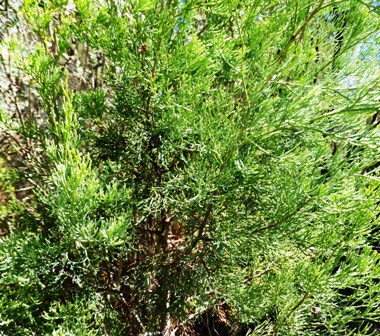
Callitris endlicheri is known as the Black Cypress Pine and reaches a maximum height of about 15 metres. The branches are erect sometimes spreading; the bark is tough and deeply furrowed. The foliage is bright green. The female cones may be solitary or several clustered together. They are egg-shaped and contain a number of sticky seeds that are coated in resin. Cones persist on the tree for a number of years.
Callistemon salignus
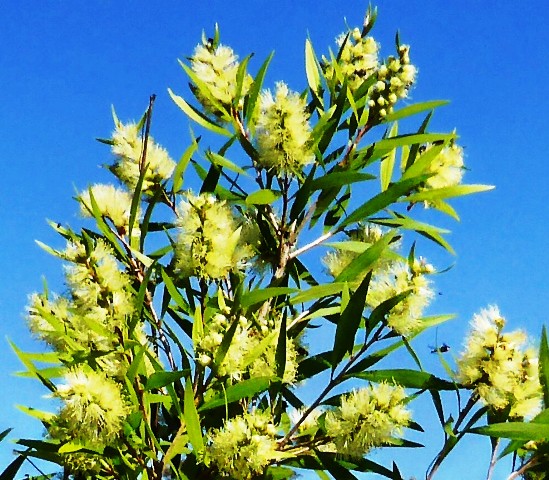
Callistemon salignus is known as the Willow Bottlebrush. The species name means willowy and refers to the growth habit. Callistemon salignus is a tall shrub or small tree. The brushes are creamy-white to yellow, five centimetres long by three centimetres wide and appear in spring. Brushes are usually abundant and conspicuous. Sometimes there are sporadic blooms in autumn.
Backhousia citriodora
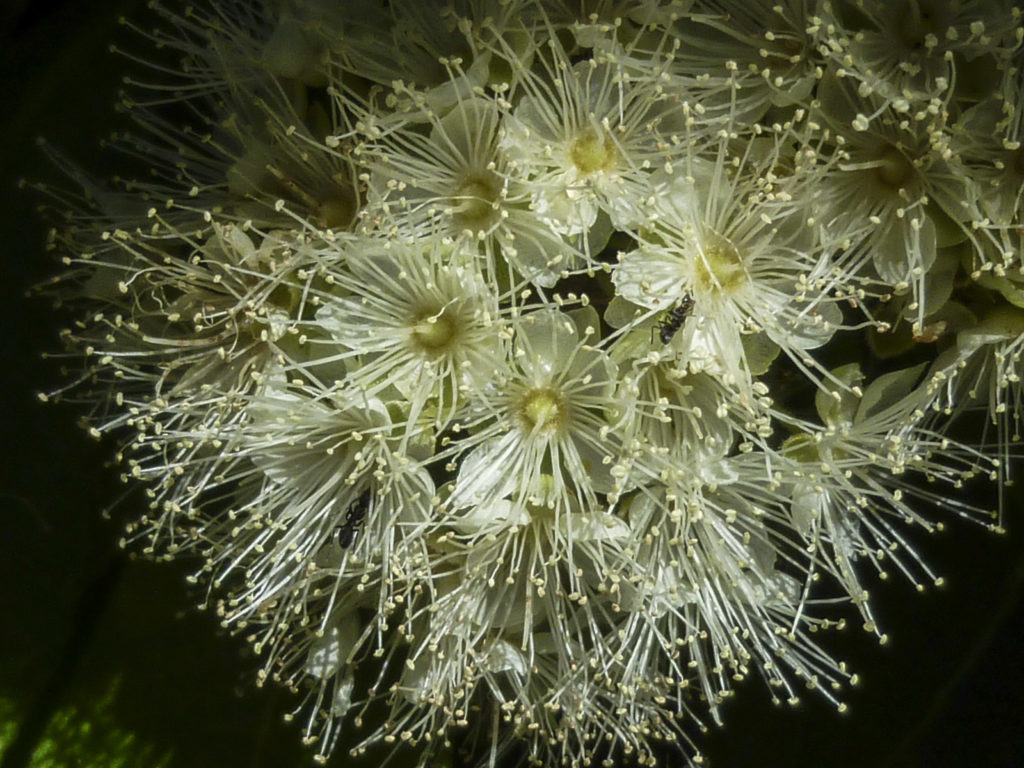
Backhousia citriodora belongs to the Myrtaceae family and is endemic to central and southern Queensland (Mackay to Brisbane). My plant is about four metres high and two metres wide and produces masses of white fluffy flowers, about one centimetre in diameter, near the end of the branchlets, in November to December. This plant is popular in cultivation for its bushy habitat, branches to ground level and strongly lemon scented leaves (that can be used in cooking).
